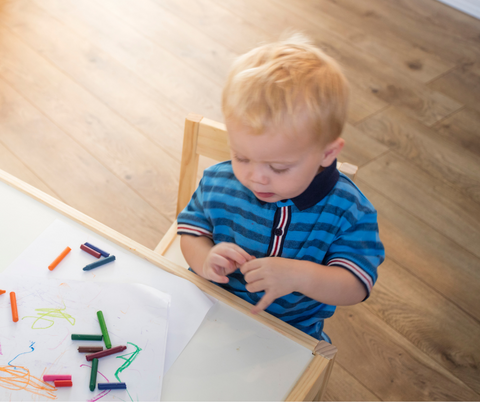The Importance of Open-Ended Play

There are now more options than ever when looking for toys for your little one! When you go into a department store, you will see shelves upon shelves of different toys: there are the ones that make all sorts of noises with the press of a button, interactive puzzles for your child to solve, animatronic pets, and so much more. It can be incredibly challenging to make a choice when you have a plethora of possibilities to decide between… so which toys are the best for your child's growth and development?
One of the most extraordinary things about children is that their creativity and imagination knows no bounds. Have you noticed that they can even be entertained by even the simplest of materials for hours on end? Research has shown that the most valuable toys for your little one's brain development are those that offer open-ended play. Not only do they engage the imagination for hours of fun, but they also enhance social and emotional intelligence, benefitting their learning and intellectual growth!
In today's blog, we'll be delving into the importance of open-ended play and how you can provide the opportunities for it during your children's playtime.

What is open-ended play?
Open-ended play is a form of play where there's no limitations, boundaries or fixed answers. With no instructions, rules or guides, there is absolutely no fear of doing anything the "wrong" way. This type of play allows children to express their creativity freely, with endless possibilities!
For example, take a pile of wooden blocks. To you, they may be just that. But to a child, they can be the building blocks to a village, castle, car garage, skyscraper, and so much more!
During open-ended play, children can fully engage their imagination as they are free to make their own decisions while exploring more about the world around them with the objects they are given.
Other examples of open-ended materials and toys include:
- Cardboard boxes
- Playdough
- Sand
- Paper

Why is open-ended play important?
The nature of open-ended play stimulates curiosity and allows your child to become absorbed in their own imagination. They become fully engaged in learning, enabling them to stretch their cognitive skills when thinking critically to lead and make choices. This type of play is especially beneficial while their brains are still rapidly developing, and will eventually support them when they become adults. It can also become a fantastic opportunity for you to teach new concepts and language skills, as it promotes interaction and encourages conversation while you play together.
When you and your child engage in role-play, whether that's pretending to be pirates sailing the seas and hunting for treasure, or lords and ladies at a grand palatial ball, you assist with their social and emotional development. That's because when they pretend to be a different character, they can explore and express a range of emotions that differ from what they would usually feel. It also helps them to read the emotions and social cues of others, based on your reactions and expressions while you play. This opens up the opportunities to learn essential concepts such as empathy, cognitive flexibility and self-regulation as well as developing memory skills. They will also learn to play more cooperatively with others, which is so incredibly important for those later stages of childhood!

How do children learn from open-ended play?
Open-ended play offers a wide array of opportunities. Because the materials come with no specific directions, guides or rules, they can be used any way your child wants! Those materials can be moved, carried, combined with others, redesigned, ordered, taken apart and reassembled as many ways as your little one wants to.
Unlike battery-operated toys that only require your child to push a button and reduce their role during playtime to that of an audience, open-ended toys get your child thinking and learning and discovering. Playing with these materials requires your child to be actively involved in finding all the ways these toys can be used, and what to do with them. By discovering what the outcomes of their decisions and actions are for themselves, they are able to learn much more efficiently than with other toys!
How do I facilitate open-ended play?
There are many ways you can encourage open-ended play, or even join in playtime, with your children. Some examples of things you can do/toys you can play with are:
- Playing on playgrounds
- Creating pictures with art supplies
- Playing dress-up with props and costumes
- Inventing games with items found in nature, such as shells and pine cones
- Creating their own little world with wooden blocks and figures
- Imaginative play with small props like tea party sets and play food
- Building with loose parts and bricks
If your child asks you for help during playtime, you can encourage them to solve the problem for themselves by asking open-ended questions. This encourages them to think about the answer, further promoting their development and growth.

At the end of the day, let your child take the lead – this is what makes it "open-ended" play after all! There should be no goals set - instead, it's all about exploring the different ways to have fun. Relax mama, and allow mistakes and mess to happen as your child goes on with their train of thought. Open-ended play not only gives a chance for your little one to grow and learn and develop as their own person, but it also makes for beautiful memories where you can bond with your baby.




